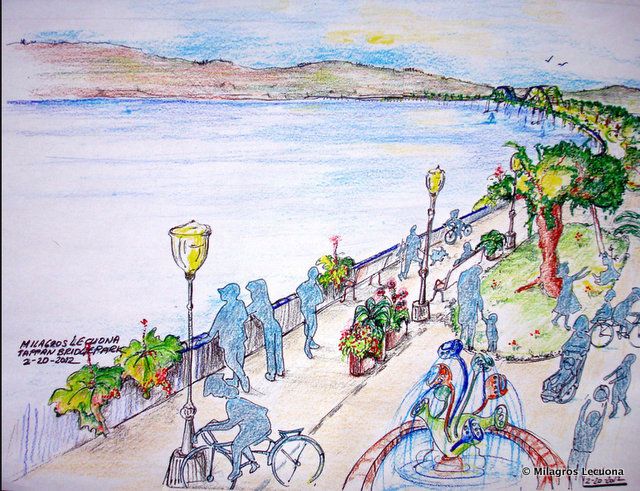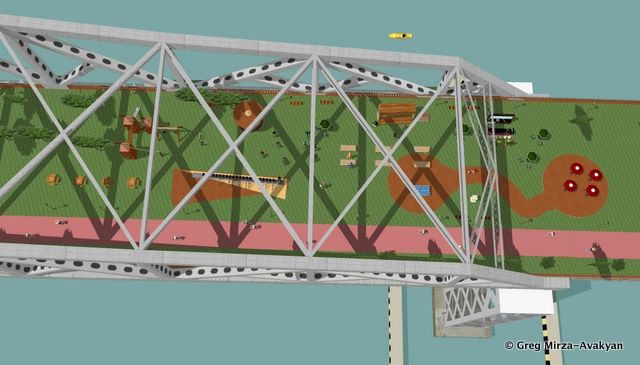Fiber Arts Take Over a Former Seaport Warehouse in NYC
See waterfalls of fabric, intricate threadwork, massive tapestries, and more!


With the possible demolition of the Tappan Zee Bridge, architecture and urban planning students at Cooper Union and Columbia University have been looking into a possible adaptive reuse. Just 20 miles north of New York City, the bridge connects Rockland and Westchester Counties, and some believe it has the potential to be made into a Hudson River destination hot spot, attracting local and regional visitors.
In 2011, a new vehicular bridge was proposed just 400 feet north of the Tappan Zee Bridge, which has surpassed its carrying capacity. Governor Andrew Cuomo has been pushing for federal backing in order to fast track the process. The new bridge, dubbed the Tappan Zee Hudson River Crossing is expected to be completed in 2017.
With the new bridge’s location just north of the current bridge, local politicians in Westchester County wondered what the fate of the old bridge would be. In response, Paul Feiner and Milagros Lecuona teamed together to form the Tappan Bridge Park Alliance, aimed at transforming the depreciating structure into a 30 acre parkland, open to the public.
 A pedestrian and cyclist haven as depicted by Milagros Lecuona.
A pedestrian and cyclist haven as depicted by Milagros Lecuona.
Initially, there had been no mention of the fate of the Tappan Zee Bridge, but when the Draft Environmental Impact Statement was released in February, it became clear that it was intended to be demolished. While, this could have been an early end for the project, striking news revived its potential. In late February, Governor Andrew Cuomo stated his interest in converting the bridge into a park. The Governor remarked that the idea was “an exciting option” and encouraged further study into its feasibility.
Throughout the past few months, the Governor’s stated interest has sparked additional attention. In April, the New York Times, among other prominent news outlets, released a feature article proclaiming different ideas on how this bridge park could become a reality. The Times specifically called upon architecture students at Cooper Union in the advanced urban theory class led by Laila Seewang to see what their expertise could yield when put to the test. Additionally, Master’s students at Columbia University in Urban Planning devised a studio surrounding the project, led by Lecuona herself. The studio identified obstacles such as funding sources, and a potential ownership structures as the biggest challenges to overcome.
 Rendering of potential park by Greg Mirza-Avakyan, MSUP Candidate 2013, GSAPP | Columbia University.
Rendering of potential park by Greg Mirza-Avakyan, MSUP Candidate 2013, GSAPP | Columbia University.
Along with the positive praise the project has received, there are still skeptics who wonder whether the cost of the bridge park is worth keeping up, or whether in the long run, the bridge should be demolished. Over the next five years, the New York State Thruway Authority plans to spend 1.5 billion dollars on the Tappan Zee Bridge just to keep it maintained for its current vehicular capacity while the new bridge is constructed. The cost of demolition is set at 150 million dollars, making the total cost of the bridge over the next five years 1.65 billion dollars (which does not include the 5 billion dollars projected to build the Tappan Zee Hudson River Crossing). An engineering feasibility report would need to be conducted in order to determine whether the bridge could withstand the tests of time, and whether the cost of maintaining the bridge as a park is a viable feasibility.
Despite the financial challenges, the project has other predecessors, such as the High Line in New York City, and the Walkway Over the Hudson in Poughkeepsie, which have proven that adaptive reuse can be a lucrative and sustainable undertaking for surrounding communities. Both projects involved the conversion of railroad tracks into pedestrian parks and have since spurred economic growth. Additionally, both projects, although completely unique in their own right, were scoffed at initially and have since ignited a great deal of interest and support in both surrounding communities. Should this project come to fruition, it could also spur economic growth in both Rockland and Westchester Counties.
Time will tell if this project has the potential to garner enough political and community support in order to turn this bridge into a park. The biggest challenge lies with its feasibility, and New York State should pursue further investigation to determine whether this structure can foster a lively destination for future generations. For New York City residents, the quick ride on the Metro North to Tarrytown would be a welcome getaway to see views of their own city while simultaneously taking in breathtaking views of the majestic Hudson River. For local residents, the park would act as a connector between two counties, currently divided. The implementation of adaptive reuse in this instance has the potential to create something magical, whether it be incredible views, a cyclist connection to surrounding trails or just the ability to walk across the Hudson River, from one county, to another.
Subscribe to our newsletter